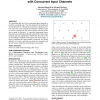Free Online Productivity Tools
i2Speak
i2Symbol
i2OCR
iTex2Img
iWeb2Print
iWeb2Shot
i2Type
iPdf2Split
iPdf2Merge
i2Bopomofo
i2Arabic
i2Style
i2Image
i2PDF
iLatex2Rtf
Sci2ools
CHI
2009
ACM
2009
ACM
Rake cursor: improving pointing performance with concurrent input channels
We investigate the use of two concurrent input channels to perform a pointing task. The first channel is the traditional mouse input device whereas the second one is the gaze position. The rake cursor interaction technique combines a grid of cursors controlled by the mouse and the selection of the active cursor by the gaze. A controlled experiment shows that rake cursor pointing drastically outperforms mouse-only pointing and also significantly outperforms the state of the art of pointing techniques mixing gaze and mouse input. A theory explaining the improvement is proposed: the global difficulty of a task is split between those two channels, and the sub-tasks could partly be performed concurrently. Author Keywords Fitts' law, multi-channel pointing, rake cursor. ACM Classification Keywords H.5.2 [Information Interfaces and Presentation (e.g., HCI)]: User Interfaces ? Graphical user interfaces, Input devices and strategies.
CHI 2009 | Human Computer Interaction | Mouse Input Device | Pointing Task | Rake Cursor Interaction |
| Added | 24 Nov 2009 |
| Updated | 24 Nov 2009 |
| Type | Conference |
| Year | 2009 |
| Where | CHI |
| Authors | Renaud Blanch, Michael Ortega |
Comments (0)

